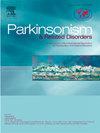帕金森病的神经炎症:使用 [11C]PBR28 PET 和脑脊液标记物进行的研究。
IF 3.1
3区 医学
Q2 CLINICAL NEUROLOGY
引用次数: 0
摘要
目的用[11C]PBR28正电子发射断层扫描(PET)和脑脊液(CSF)生物标记物研究帕金森病(PD)的神经炎症,以及与6-[18F]-氟-L-多巴([18F]FDOPA)PET测量的多巴胺能功能的关系:临床队列包括20名帕金森病患者和51名健康对照组(HC)。所有健康对照组和 15 名帕金森病患者都接受了[11C]PBR28 高分辨率研究断层扫描(HRRT)正电子发射计算机断层扫描,以定量评估大脑与神经炎症标志物易位体蛋白(TSPO)的结合情况。17名帕金森氏症患者和21名白血病患者的脑脊液样本接受了可溶性髓系细胞上表达的触发受体2(sTREM2)、几丁质酶3样1蛋白(YKL-40)、神经粒蛋白(NG)、α-突触核蛋白(aSyn)和寡α-突触核蛋白的检测。所有患有帕金森病的受试者都接受了[18F]FDOPA HRRT PET检查:结果:虽然帕金森病受试者和HC受试者在任何研究脑区的[11C]PBR28总分布容积(VT)上没有差异,但神经炎症和神经变性CSF生物标志物sTREM2和NG水平较高分别与帕金森病统一量表运动部分(UPDRS-III)评估的较严重运动症状相关(r = 0.52,p = 0.041和r = 0.59,p = 0.016)。此外,在帕金森病组中,基底节和黑质(SN)中[11C]PBR28 VT的增加与神经炎症生物标志物YKL-40水平的升高有关(p 结论:在帕金森病组中,基底节和黑质中[11C]PBR28 VT的增加与神经炎症生物标志物YKL-40水平的升高有关:CSF生物标志物、运动障碍与纹状体和黑质中的[11C]PBR28 VT之间的关联可能支持神经炎症在帕金森病中的作用。本文章由计算机程序翻译,如有差异,请以英文原文为准。
Neuroinflammation in Parkinson’s disease: A study with [11C]PBR28 PET and cerebrospinal fluid markers
Objective
To investigate neuroinflammation in Parkinson's disease (PD) with [11C]PBR28 positron emission tomography (PET) and cerebrospinal fluid (CSF) biomarkers, and the relationship to dopaminergic functioning measured with 6-[18F]-fluoro-L-dopa ([18F]FDOPA) PET.
Methods
The clinical cohort consisted of 20 subjects with PD and 51 healthy controls (HC). All HC and 15 PD participants underwent [11C]PBR28 High Resolution Research Tomograph (HRRT) PET for the quantitative assessment of cerebral binding to the translocator protein (TSPO), a neuroinflammation marker. CSF samples were available from 17 subjects with PD and 21 HC and were examined for soluble triggering receptor expressed on myeloid cells 2 (sTREM2), chitinase 3-like 1 protein (YKL-40), neurogranin (NG), alpha-synuclein (aSyn) and oligo-alpha-synuclein. All subjects with PD underwent [18F]FDOPA HRRT PET.
Results
While the subjects with PD and HC did not differ in the total volume of distribution (VT) of [11C]PBR28 in any studied brain regions, higher levels of neuroinflammation and neurodegeneration CSF biomarkers sTREM2 and NG, respectively were associated with more severe motor symptoms evaluated by The Unified Parkinson's Disease Rating Scale motor part (UPDRS-III) (r = 0.52, p = 0.041 and r = 0.59, p = 0.016 respectively). Additionally, in the PD group increased [11C]PBR28 VT in the basal ganglia and substantia nigra (SN) was related to higher levels of neuroinflammation biomarker YKL-40 (p < 0.01).
Conclusion
Associations between CSF biomarkers, motor disability and [11C]PBR28 VT in the striatum and SN may support a role for neuroinflammation in PD.
求助全文
通过发布文献求助,成功后即可免费获取论文全文。
去求助
来源期刊

Parkinsonism & related disorders
医学-临床神经学
CiteScore
6.20
自引率
4.90%
发文量
292
审稿时长
39 days
期刊介绍:
Parkinsonism & Related Disorders publishes the results of basic and clinical research contributing to the understanding, diagnosis and treatment of all neurodegenerative syndromes in which Parkinsonism, Essential Tremor or related movement disorders may be a feature. Regular features will include: Review Articles, Point of View articles, Full-length Articles, Short Communications, Case Reports and Letter to the Editor.
 求助内容:
求助内容: 应助结果提醒方式:
应助结果提醒方式:


